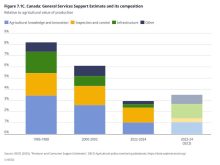The Canadian Wheat Board (CWB) defended its controversial decision to buy into the Great Lakes shipping fleet last week, saying it will ultimately mean higher returns for farmers.
The board’s goal is not only to get the best returns for farmers, but to cut their costs too, said CWB chair Allen Oberg.
Oberg said the decision to buy two new ships to haul Prairie grain to eastern ports will earn farmers $10 million a year, net of operating expenses, and help ensure the viability of the Great Lakes-St. Lawrence as a shipping option.
Read Also

Local farm businesses, groups look forward to Manitoba Ag Days 2026
Most of agriculture is seemingly at Manitoba Ag Days each January: Manitoba agribusinesses and farm groups look forward to connecting with farmers at the 2026 show.
“This is a project that has a very solid business case and it’s going to serve farmers very well into the future,” CWB chair Allen Oberg told reporters Feb. 8 while announcing the $65-million purchase, which will come from earnings to the pool accounts.
RITZ SAYS RECKLESS
Agriculture Minister Gerry Ritz says the CWB should focus on getting higher prices for farmers instead of buying ships.
“We believe this decision will put $65 million of farmers’ money at risk and could lower pool returns,” Ritz said in an emailed statement. “Farmers have not been consulted on this decision and their money should not be spent recklessly.”
The CWB spends $70 million to $75 million a year moving grain through the Great Lakes-St. Lawrence Seaway system to export. When its new ships begin operating in 2013, some of will be clawed back.
“I certainly don’t think this is a reckless investment,” Oberg said. “We’re looking at a payback period of less than eight years on this investment at an internal rate of return of over 15 per cent.
“Farmers elect a board of directors to make decisions on their behalf and we’ve always believed our organization has the ability to reduce their costs through the involvement in logistics, such as our involvement in rail hopper cars, and this investment in lake vessels is just a further extension of that.”
VESSEL POOL
The two ships the CWB is buying are part of a seven-ship purchase by Algoma and Upper Lakes. The ships, which are being built in China, will be managed and operated by Seaway Marine Transport, which is jointly owned by Algoma and Upper Lakes.
“These vessels will operate as part of a vessel pool with our partners so we’ll be sharing in any profits that are generated by that pool,” Oberg said.
Although the CWB exports most of its grain through West Coast ports, about five million tonnes through east ports annually, CWB chief operating officer Ward Weisensel said in an interview. Around three million tonnes of the eastern movement are shipped in aging lake vessels. The last one was built in 1983 with an investment from the CWB.
“At some point the decision had to be made to renew the fleet,” Weisensel said. “This is something that has been under discussion for a number of years, but the cost of doing so has been very prohibitive.”
That is until recently. Weisensel said three things have changed – the federal government scrapped the 25 per cent tariff on foreign-built ships, the Canadian dollar is strong (ships are priced in U.S. dollars) and there’s excess shipbuilding capacity due to the global recession.
SEAWAY ROUTE
Maintaining the seaway is important to all Prairie farmers, but especially those on the eastern Prairies, he said.
“It’s very important for durum,” Weisensel said. “About 40 per cent or more of world (durum) trade is basically North Africa – Tunisia, Morocco, Algeria – and a big chunk of durum goes into Europe as well.”
Without access to the seaway the CWB would have to ship grain east by rail.
“The St. Lawrence Seaway has been an important piece to keep rail rates lower to access the St. Lawrence terminals,” Weisensel said.
“The rate structure on winter rail on a per-tonne-mile basis is cheaper than other moves because of the seaway.”
Meanwhile, the CWB is project ing eastern movement will continue to increase. Populations are growing faster in Africa, the Middle East and Latin America than anywhere else, Rick Steinke, the CWB’s vice-president of logistics told the Fields on Wheels conference in Winnipeg Dec. 3.
“It means we’re going to see more demand out of the Atlantic and it means we’re more bullish on eastern movement and north movement than we are in western movement,” Steinke said, looking out to 2018.
CWB president and CEO Ian White said the CWB will pay for the ships over four years.
“That works out to about $1 a tonne (on every tonne of grain marketed) over the four years,” he said. “The boats have a lifespan of about 25 years so farmers will continue to reap the financial benefits well into the future.”
The grain fleet will haul grain east from Thunder Bay and Duluth and backhaul iron ore to Canadian and American steel mills.
The new Equinox vessels will be state of the art, according to White. Although the ships’ dimensions will be the same as existing lakers to fit through seaway locks, the new ships will hold 30,000 tonnes, up 5,000 tonnes thanks to an improved hull design, he said. The new ships will be faster, use less fuel and be more environmentally friendly.
MIXED REACTION
The Keystone Agricultural Producers (KAP), Canadian Federation of Agriculture, National Farmers Union and Farmers of North America have endorsed the CWB’s plan based on projections that it will save farmers money and improve grain movement.
“KAP thinks that will give improved returns to western Canadian farmers and is going to be good for our members,” KAP president Doug Chorney said in an interview.
The Western Canadian Wheat Growers Association (WCWGA), Grain Growers of Canada and Western Barley Growers Association have criticized the purchase. The WCWGA has asked Minister Ritz to block the deal.
“The CWB board of directors should not be taking money from farmers to finance the purchase of ships or any other capital asset,” WCWGA president Kevin Bender said in a release. “Farmers on the verge of retirement, needing the money or wanting to invest elsewhere should not be compelled to buy ships.”
The WCWGA says the CWB’s ship purchase favours one grain pipeline over another.
But White said owning ships doesn’t put the CWB in a conflict of interest and won’t influence the direction grain flows.
“We will continue looking for the cheapest, least cost to market for farmers,” he said. “We will only be shipping grain out of the seaway that is logical to go there.” [email protected]
———
“Atsomepointthedecisionhadtobemadetorenewthefleet.”
–[WARD WEISENSEL















